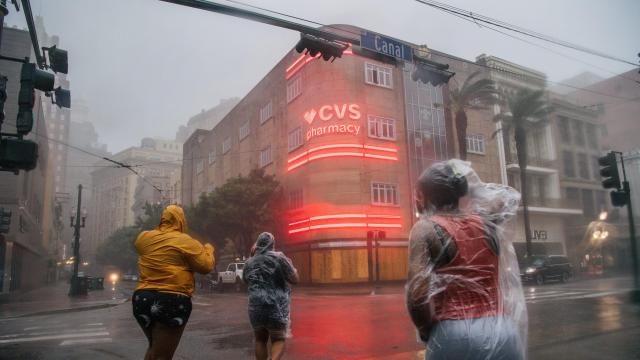All of New Orleans lost power Sunday night after Hurricane Ida brought down eight transmission lines that deliver electricity to the city, according to a new report from Nola.com. Everyone in Orleans parish, home to New Orleans, lost power around 7:15 p.m. local time, 8:15 p.m. ET, and it’s not clear when power might be restored.
Local utility Entergy said it was dealing with “catastrophic transmission damage.” WWLW investigative reporter David Hammer tweeted that the company had eight transmission lines go down, leading to the massive blackout. The main transmission tower has collapsed into the Mississippi River.
About 993,000 people in Louisiana and about 32,000 people in Mississippi are currently without power, according to PowerOutage.US, which tracks power outages across the country. Local news station WWL-TV in Louisiana reports that while phone calls are going straight to voicemail in the region, some text messages are getting through. New Orleans’ 96 pumps that help the city cope with stormwater have also lost power from Entergy, forcing the city’s Sewerage & Water Board that operates the system to rely on electricity generated in-house. Their continued operation is vital as the city is expected to receive up to 51 centimetres of rain from Ida.
Hurricane Ida, a slow-moving Category 4 storm, first made landfall around noon local time at Port Fourchon, roughly 161 kilometres south of New Orleans, and then again at Galliano, about 113 kilometres south of New Orleans, around 2 p.m. local time. At the time of landfall, Ida had winds of 240 km/h. The storm maintained remarkable intensity as it crawled inland and has only recently begun to weaken wind-wise, though it’s still packing a punch and heavy rain and surf are wreaking havoc.
Incredibly, the Mississippi River even reversed course earlier this evening, temporarily flowing south to north in a move that’s likely to increase the expected flood damage in the state.
The devastation of this hurricane is only beginning to be felt, with reports of people in Louisiana also losing water in their homes. Jefferson Parish is reportedly losing 946,353 litres of water per hour, according to WWL-TV, caused by fallen trees that have damaged the water system.
To make matters even worse, Louisiana has struggled recently with an enormous surge in covid-19 cases, pushing the local health system to the max. The state reported 3,428 new covid-19 cases on Friday alone, with roughly 84% of Louisiana’s ICU beds currently occupied. NOLA.com reported that a backup generator failed at Thibodaux Regional Health System in Lafourche Parish, forcing medical staff to manual pump air in and out of patients’ lungs while they transported them to a part of the hospital that still had power.
State Rep. Jerome Zeringue described the scene as “Katrinaesque.” (Hospitals notoriously lost power during Katrina and generators failed, contributing to mass deaths.)
Watching Ida, it’s once again clear that various parts of the U.S. energy grid are simply too antiquated to stand up to the conditions the climate crisis has wrough. The most notorious example of a grid failing is Puerto Rico in the wake of Hurricane Maria. But hurricanes are far from the only climate disasters that threaten the power supply.
This year alone, the Texas energy grid failed catastrophically after extreme cold hit the state, leaving hundreds dead across the state. (It’s almost failed twice again this summer.) And California’s grid has been stressed this summer amid wildfires, just as it has in other recent years. Declining water levels at the state’s reservoirs and hydropower dams have added further stress.
All these disasters have shown why we need a modernised grid, one that at once connects broader swaths of the country and has built-in resilience measures to deal with increasingly, hot, fiery, stormy, and dry conditions. (Obviously it would also kick fossil fuels to the curb.) That’s a long-term project, though.
If you’re staring at the news from outside the region and wondering what you can do to help Ida survivors right now, we’ve created a guide on different ways that you can help victims of the hurricane right now.
